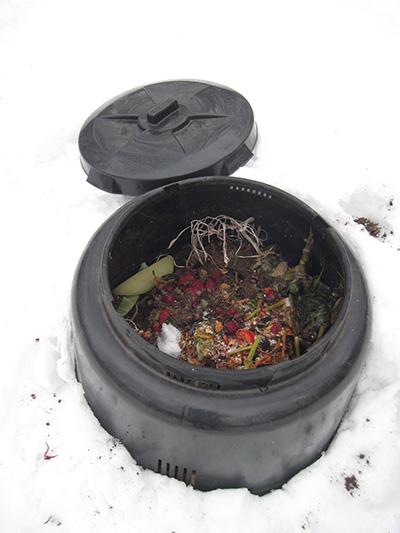
Composting year-round puts kitchen scraps and forgotten leftovers to good use.
We all have our ways of coping with a spring as late in coming as this one. As a gardener itching to start digging, I’m clinging to my composting habit, reading books about it and seeing promise in potato peels, coffee grounds and radish tops.
No matter that my compost bin is entombed in crusty snow. No matter that the leftovers I dragged from the back of the fridge over the past months and glopped on top of the pile now look like a macabre frozen shrine to decay. My weekly walk across the backyard tundra to add to that pile is resolute. I avert my eyes from the garden itself, because the plow guy has dumped a mountain of snow on top, big enough for my kids to dig a tunnel through. Once to the compost bin, I linger and imagine: I am warm, dressed in shorts, and pitching my shovel into the bin to scoop out crumbly, black compost to feed my soil.
Ahhh. Are those butterflies and violins I’m seeing and hearing? More likely, it will be black flies and buzzing mosquitoes, but hey, this is my fantasy!
It’s no fantasy that compost improves gardens. Compost is amazing, magical stuff. You pile up kitchen scraps, grass clippings, leaves, manure and whatever other organic matter you can find, and with very little help from you it eventually heats up, rots and transforms into the very nutrients veggies and flowers must have. Generally the more compost you add to your garden, the better plants grow. Compost builds soil structure and helps it hold onto water.
Some gardeners stick with the abundance of yard waste for composting, but adding kitchen scraps to the mix brings the process to a whole new level. Uneaten food, says the EPA, is the largest waste stream by weight in the U.S. That means we’re trussing up valuable nutrients into plastic bags and storing them in landfills for hundreds of years until the plastic breaks down. Instead, we could be turning that food into compost to make bigger begonias and tastier tomatoes in our gardens.
Utilizing all kinds of organic matter for composting best mimics the natural processes of a healthy forest, where nothing goes to waste. In a forest, literally tons of leaves and twigs fall to the ground each year, not to mention plenty of animal waste and dead animal bodies. Billions of fungi (we don’t even know how many species exist!), bacteria and other microorganisms feast on all of it, breaking it down and releasing nutrients into the soil, where tree and plant roots reach out to absorb them. The layer of duff on the forest floor is a perfectly moist and protected setting for seeds to germinate. Forest microorganisms also eat toxins like pesticides, keeping at least some of them from reaching water and becoming pollutants.
The same feasting happening on the forest floor is happening in compost piles, which teem with life we can’t see. I like how author Gene Logsdon likens composting to running a tiny livestock venture in his book called The Gardener’s Guide to Better Soil: “The compost heap is a big pile of food for the smallest but most necessary “livestock” you are privileged to care for on your land – soil microorganisms.”
It’s ironic that for thousands of years farmers and in more modern times gardeners, too, have mimicked the natural processes of the forest for growing food, but we still have a long way to go before we fully grasp the complexity of it all. At Harvard University’s Harvard Forest, for example, hundreds of scientists from eight institutions took 100,000 measurements of forest soil respiration over the past 22 years in the quest to “cast new light” on just one aspect: how carbon cycles through plants and soils, according to Harvard’s website.
What we do know is that we depend on healthy forests. Their trees give us oxygen and absorb carbon dioxide. Their soils filter water and recycle nutrients. That we don’t understand all the particulars is one more reason to conserve our forests, as if we needed one more.
Composting, even when it’s too cold for decomposition to start, lets me play a small part in nutrient recycling on my own little patch of soil. It’s a practice that reminds me that something sweet can come from something rotten. Winter will turn to spring. Simple yet satisfying. As Logsdon points out, “composting is probably the only “manufacturing” process civilization has yet devised in which neither input nor output is a drain on natural resources. Composting is the one way you can eat your cake and have it, too.”
And if I happen to let a leftover piece of that cake get too old in the fridge, I’ll just toss it onto the compost pile.
